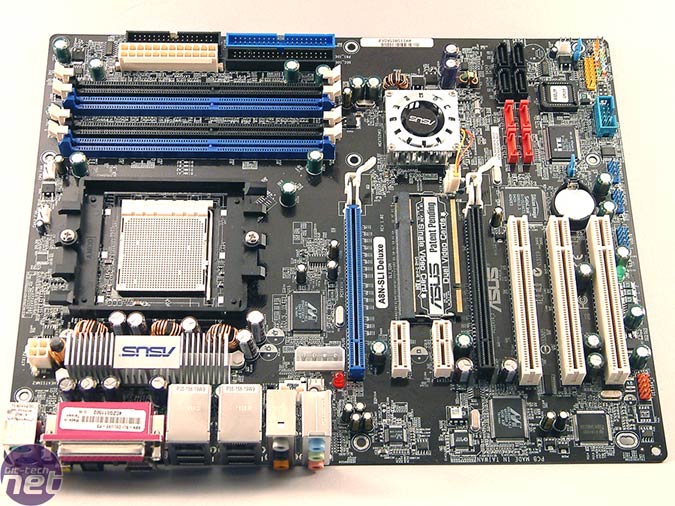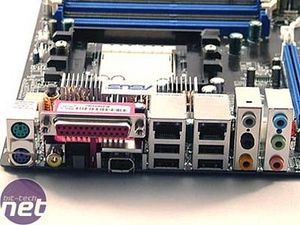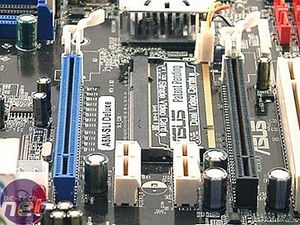NVIDIA's SLI: Part 1 - Motherboards
May 16, 2005 | 09:31

ASUS A8N-SLI Deluxe - The Board
 Generally, the board design is a good one. However, the space around the blue PCI-Express x16 slot isn't ideal when using a video card such as a GeForce 6800 Ultra - you need to remove the video card before you can swap memory in and out of the DIMM slots. The additional power required for SLI configurations, which ASUS term an EZ Plug, is not in the most ideal position either as it is right next to the back plate end of the blue primary PCI-Express x16 slot, meaning that a power cable has got to reach all the way across the motherboard - just a little untidy in our opinion.
Generally, the board design is a good one. However, the space around the blue PCI-Express x16 slot isn't ideal when using a video card such as a GeForce 6800 Ultra - you need to remove the video card before you can swap memory in and out of the DIMM slots. The additional power required for SLI configurations, which ASUS term an EZ Plug, is not in the most ideal position either as it is right next to the back plate end of the blue primary PCI-Express x16 slot, meaning that a power cable has got to reach all the way across the motherboard - just a little untidy in our opinion.
The area around the CPU socket is fairly clutter free and there is plenty of room to implement even the largest of CPU coolers. Just below the CPU socket, there is a large multi-fin heatsink design covering the mosfets that supply power to the processor. This area can get very hot, certainly with the power that the high end CPUs draw in this day and age - hence why ASUS have implemented a cooler in their motherboard design. To the left of the mosfets, there is the ATX 12v power connector - it is in an ideal place on the edge of the motherboard that is closest to the power supply. To the right of the mosfet cooler, there are the CD-In and AUX-In audio connectors. There's also an LED warning light next to the EZ plug, which illuminates when two video cards are installed without the additional 4-pin molex lead inserted.
The DIMM slots are coded by colour - memory modules need to be installed in to either the two blue or two black slots to enable Dual Channel memory. Above the DIMM slots, there is the 24-pin ATX power connector that supports both 24-pin and 20-pin ATX power supplies, along with two ATA133 ports and a floppy disk drive port.
Moving to the right hand portion of the motherboard, the chipset fan is located in between the two PCI-Express x16 slots, which should, by rights, allow you to install a third party cooler or water block on to the NForce4 SLI MCP. To the right of the MCP, there are the eight SATA ports in two colour-coded sets of four ports. The black ports are controlled by the inbuilt NVIDIA RAID controller, while the red ports are linked to the Silicon Image 3114 controller located next to the left hand PCI slot.
Along the right hand edge of the motherboard going from top to bottom, there is the power/reset output header for connection to your cases' power and reset switches, the COM port header, three USB headers near the CMOS battery and CMOS reset jumper and then finally, there is the additional IEEE 1394 Firewire header located next to the bottom corner of the right-hand PCI slot.

 In between the two PCI-Express x16 slots, there are two PCI-Express x1 slots and the ASUS SLI EZ connector card and port that controls the PCI-Express lane configuration, depending on whether you have one or two video cards installed. The SLI EZ card clips in and requires minimal effort to change video card modes. This design is slightly different from any other motherboard, as there is the extra free slot in between the two x16 interconnects that may well improve the airflow around two GeForce 6800 Ultras, for example.
In between the two PCI-Express x16 slots, there are two PCI-Express x1 slots and the ASUS SLI EZ connector card and port that controls the PCI-Express lane configuration, depending on whether you have one or two video cards installed. The SLI EZ card clips in and requires minimal effort to change video card modes. This design is slightly different from any other motherboard, as there is the extra free slot in between the two x16 interconnects that may well improve the airflow around two GeForce 6800 Ultras, for example.
The BIOS
ASUS are using an AMI AwardBIOS on the A8N-SLI Deluxe that is a little different to a more conventional motherboard BIOS - ASUS lays its BIOS out in an unorthodox fashion, but once you have got used to it, the BIOS is a fairly complete package with enough fruit for the majority of tweakers out there.
Voltage and CPU multiplier adjustments can be found under the 'Jumper Free Configuration' menu. The voltage ranges are relatively good, with 1.65v vCore available for the CPU in 0.025v increments, while there is 3.0v available on vDIMM in 0.05v increments. Interestingly, the menu for tweaking memory timings is found under the 'CPU Configuration' menu - a rather odd place in our opinion, but as already mentioned, the BIOS is a very solid once you have got used to it being a tad unconventional.

The area around the CPU socket is fairly clutter free and there is plenty of room to implement even the largest of CPU coolers. Just below the CPU socket, there is a large multi-fin heatsink design covering the mosfets that supply power to the processor. This area can get very hot, certainly with the power that the high end CPUs draw in this day and age - hence why ASUS have implemented a cooler in their motherboard design. To the left of the mosfets, there is the ATX 12v power connector - it is in an ideal place on the edge of the motherboard that is closest to the power supply. To the right of the mosfet cooler, there are the CD-In and AUX-In audio connectors. There's also an LED warning light next to the EZ plug, which illuminates when two video cards are installed without the additional 4-pin molex lead inserted.
The DIMM slots are coded by colour - memory modules need to be installed in to either the two blue or two black slots to enable Dual Channel memory. Above the DIMM slots, there is the 24-pin ATX power connector that supports both 24-pin and 20-pin ATX power supplies, along with two ATA133 ports and a floppy disk drive port.
Moving to the right hand portion of the motherboard, the chipset fan is located in between the two PCI-Express x16 slots, which should, by rights, allow you to install a third party cooler or water block on to the NForce4 SLI MCP. To the right of the MCP, there are the eight SATA ports in two colour-coded sets of four ports. The black ports are controlled by the inbuilt NVIDIA RAID controller, while the red ports are linked to the Silicon Image 3114 controller located next to the left hand PCI slot.
Along the right hand edge of the motherboard going from top to bottom, there is the power/reset output header for connection to your cases' power and reset switches, the COM port header, three USB headers near the CMOS battery and CMOS reset jumper and then finally, there is the additional IEEE 1394 Firewire header located next to the bottom corner of the right-hand PCI slot.


The BIOS
ASUS are using an AMI AwardBIOS on the A8N-SLI Deluxe that is a little different to a more conventional motherboard BIOS - ASUS lays its BIOS out in an unorthodox fashion, but once you have got used to it, the BIOS is a fairly complete package with enough fruit for the majority of tweakers out there.
Voltage and CPU multiplier adjustments can be found under the 'Jumper Free Configuration' menu. The voltage ranges are relatively good, with 1.65v vCore available for the CPU in 0.025v increments, while there is 3.0v available on vDIMM in 0.05v increments. Interestingly, the menu for tweaking memory timings is found under the 'CPU Configuration' menu - a rather odd place in our opinion, but as already mentioned, the BIOS is a very solid once you have got used to it being a tad unconventional.

MSI MPG Velox 100R Chassis Review
October 14 2021 | 15:04





Want to comment? Please log in.